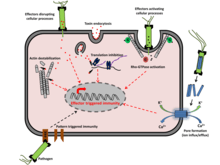Effector-triggered immunity
Effector-triggered immunity (ETI) is a property of the innate immune system. ETI was first identified in plants[1][2] but has also been identified in animal cells.[3]

The host cell detects the presence of the pathogen directly from the molecular patterns on the pathogen and indirectly through the damage caused to the host cell by the toxins generated by the pathogen.
The innate immune system is common to all multicellular organisms and forms the first line of defense against pathogens. Infected cells recognize that they are under attack by detecting the pathogen directly through the Pathogen Associated Molecular Patterns (PAMPS) which bind with the Pattern Recognition Receptors (PRR) on the host cells. Host cells also recognize the pathogen through effector-triggered immunity,[4] whereby the host cells are alerted to the pathogen by the associated damage caused by pathogenic toxins or effectors.
References
- Spoel, SH (February 2012). "How do plants achieve immunity? Defence without specialized immune cells". Nature Reviews Immunology. 12: 89–100. doi:10.1038/nri3141. PMID 22273771.
- Gassmann, Walter; Bhattacharjee, Saikat (2012). "Effector-Triggered Immunity Signaling: From Gene-for-Gene Pathways to Protein-Protein Interaction Networks". Molecular Plant-Microbe Interactions. 25 (7): 862–868. doi:10.1094/MPMI-01-12-0024-IA.
- Stuart, Lynda M.; Paquette, Nicholas; Boyer, Laurent (15 February 2013). "Effector-triggered versus pattern-triggered immunity: how animals sense pathogens". Nature Reviews Immunology. 13 (3): 199–206. doi:10.1038/nri3398. PMC 4121468. PMID 23411798.
- Rajamuthiah, Rajmohan (May 2014). "Effector triggered immunity: Activation of innate immunity in metazoans by bacterial effectors". Virulence. 5: 697–702. doi:10.4161/viru.29091. PMC 4189875. PMID 25513770.
This article is issued from Wikipedia. The text is licensed under Creative Commons - Attribution - Sharealike. Additional terms may apply for the media files.